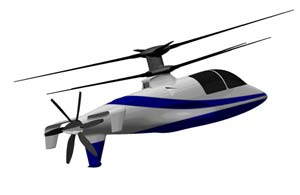Sikorsky's unique X2 design performs inaugural flight
30 Aug 2008
Almost three years after it first announced the X2 ''technology demonstrator,'' Sikorsky's compound helicopter made its first flight at the Sikorsky-Schweizer rapid prototyping facility in Horseheads, New York on 27 August.
During the 30-minute flight, Sikorsky chief test pilot Kevin Bredenbeck conducted slow forward flight, hover and hover-turn maneuvers. The craft's unique feature, a rear propulsor, was not engaged during the inaugural flight, and the X2 reached a maximum forward speed of 20 knots.
 Sikorsky said more slow flight testing will be conducted at Horseheads before the X2 is transferred to the company's larger West Palm Beach, Fla. flight-test facility. Sikorsky is self-financing the fly-by-wire X2 and will deploy its key components in future manned and unmanned military helicopters.
Sikorsky said more slow flight testing will be conducted at Horseheads before the X2 is transferred to the company's larger West Palm Beach, Fla. flight-test facility. Sikorsky is self-financing the fly-by-wire X2 and will deploy its key components in future manned and unmanned military helicopters.
The X2 technology consists of a suite of systems that Sikorsky says could let a helicopter "cruise comfortably" at 250 knots. This is far quicker than most current rotary wing aircraft are capable of. The UH-60L Blackhawk variant, for instance, can manage about 150 knots.
The tilt-wing MV-22 Osprey, meanwhile, can hit speeds upward of 240 knots, but once again this is a hybrid aircraft - half helicopter and half airplane. Though it can hover like a helicopter when its propellers are turned upwards, it needs to fly like a plane when it has to go fast. With the X2, Sikorsky clearly has the Osprey in its gunsight as the product it has to replace.
According to Sikorsky, the technologies being developed as part of the X2 programme include an integrated Fly-by-Wire system that allows the engine/rotor/propulsor system to operate efficiently, with full control of rotor rpm throughout the flight envelope, high lift-to-drag rigid blades, low drag hub fairings, and Active Vibration Control.
In addition, the aircraft will be used as a 'flying wind tunnel' to determine the main rotor to propulsor aerodynamic interaction, shaft angle optimization for performance, and blade tip clearance for a range of maneuvers.
Power for the X2 comes from a single LHTEC–Light Helicopter Turbine Engine Company, a Rolls-Royce and Honeywell partnership–T800 turboshaft engine rated at up to 1,680 shp. The T800 drives the twin four-blade Eagle Aviation contra-rotating main rotors and the Aero Composites six-blade pusher propeller mounted at the end of the tail-boom.





















